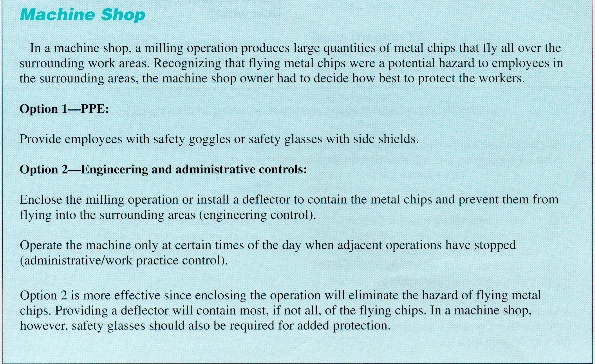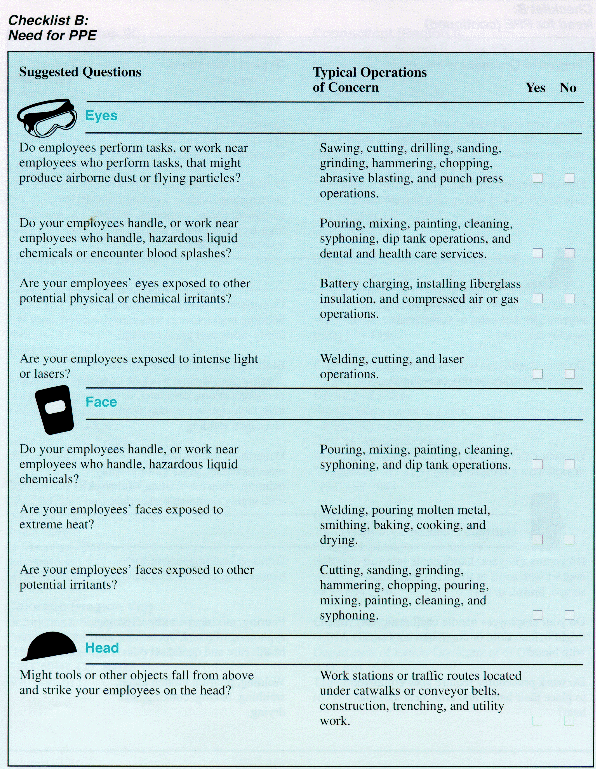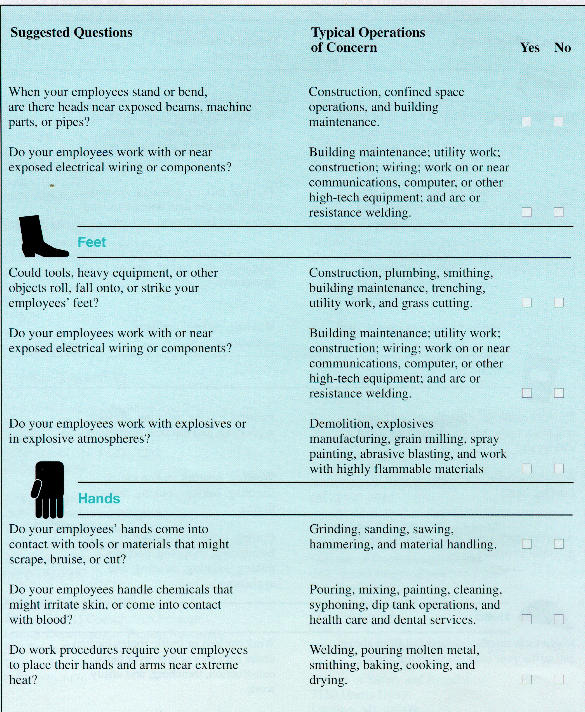
 Assessing the Need
Assessing the Need
for Personal Protective Equipment:
A Guide for Small Business Employers
Small Business Safety Management Series
U.S. Department of Labor
Occupational Safety and Health Administration
OSHA 3151
1997
The materials in this handbook are based upon the federal OSHA standards and other requirements in effect at the time of publication, and upon generally accepted principles and activities within the job safety and health field, but should not be considered as a substitute for the standards.
This booklet is not intended to be a legal interpretation of the provisions of the Occupational Safety and Health Act of 1970 or to place any additional requirements on employers or employees.
The material presented herein will be useful to small business owners or managers and can be adapted to individual establishments.
All employers should be aware that there are certain states (and similar jurisdictions) which operate their own programs under agreement with the U.S. Department of Labor, pursuant to section 18 of the Act. The programs in these jurisdiction may differ in some details from the federal program.
Material contained in this publication is in the public domain and may be reproduced, fully or partially, without permission of the Federal Government. Source credit is requested but not required.
This information will be made available to sensory impaired individuals upon request. Voice phone: (202) 219-7056. TDD message referral phone: 1-800-326-2577.
If you employ one or more persons, you should read this guide.
How will this guide help protect my employees?
The Occupational Safety and Health Administration (OSHA) requires employers to protect their employees from workplace hazards such as machines, work procedures, and hazardous substances that can cause injury. The preferred way to do this is through engineering controls or work practice and administrative controls, but when these controls are not feasible or do not provide sufficient protection, an alternative or supplementary method of protection is to provide workers with personal protective equipment (PPE) and the know-how to use it properly.
This guide will help you to
This guide will help you comply with OSHA's general PPE requirements, but it is not a substitute for OSHA standards requiring PPE (Title 29, Code of Federal Regulations [CFR] 1910.132).(1) This standard requires employers to establish general procedures, called a PPE program, to give employees necessary protective equipment and to train them to use it properly. Respirators and insulating devices are not included in this guide because OSHA requires employers to develop separate programs specifically addressing the issues associated with those types of protective devices (29 CFR 1910.134 and 29 CFR 1910.137, respectively). Although not specifically directed to construction and maritime industry, the information, methods, and procedures in this guide are also applicable to, and will help you comply with, OSHA's general PPE requirements for the construction industry at 29 CFR 1926.95 and for the maritime industry at 29 CFR 1915.152.
Although the checklists and other information presented in this guide are intended to help you to the greatest extent possible, please keep in mind that this publication is general in nature and does not address all workplace hazards or PPE requirements.
What is personal protective equipment?
Personal protective equipment, or PPE, includes a variety of devices and garments to protect workers from injuries. You can find PPE designed to protect
Respirators and rubber insulating equipment (gloves, sleeves, blankets) are also considered PPE, but because OSHA has specific requirements for those kinds of PPE, this general guide does not address such equipment. For assistance in determining the need for and the appropriate choice of respiratory protection for your employees, see OSHA Instruction CPL 2-2.54, Respiratory Protection Program Manual.(2)
This program sets out procedures for selecting, providing, and using PPE as part of your routine operation. A written PPE program is easier to establish and maintain as company policy and easier to evaluate than an unwritten one.
How do I develop a PPE program for my company?
You have already begun to establish a PPE program by thinking about how best to protect your employees from potential hazards. Use Checklist A for information on establishing a PPE program. Working through the PPE selection process in this guide will produce the foundation for your program. Then you will need to decide how to enforce PPE use at your facility, provide for any required medical examinations, and evaluate your PPE program.
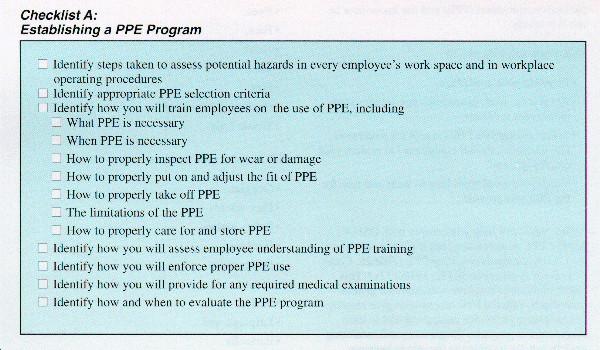
You must provide PPE for your employees if
AND
How do I identify potential hazards in my workplace?
Begin with a survey of your workplace. Observe the environment in which your employees work. Ask employees how they perform their tasks. Look for sources of potential injury such as the following:
Checklist B at the end of this section will help you conduct this survey.
I have identified potential
hazards.
Now what?
Determine if there are feasible engineering and work practice controls that could be
used to avoid hazards.
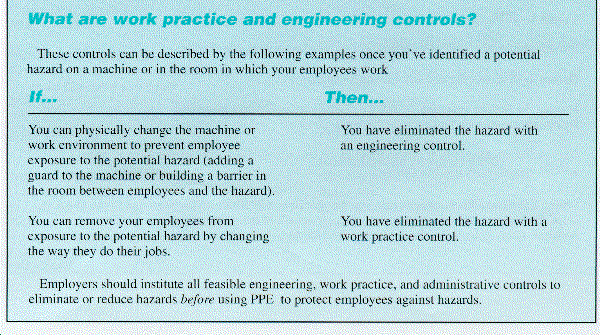
All feasible engineering and work practice controls are in place, but my employees are still exposed to potential hazards. Is now the time to provide PPE?
Yes. You must examine each likely hazard very carefully and determine the nature of the threat the hazard poses to your employees. Then choose the appropriate PPE for protection against that hazard, and make sure that any PPE you choose will fit the employee(s) who must wear it. Next, train your employees in the proper use and care of the PPE you provide.
How do I get started assessing my workplace operations for PPE needs?
Use Checklist B to assess the work environment and procedures. Keep in mind, though, that this is not an exhaustive list of operations that could cause injury. Many workplace operations create hazards; all of them could not be listed here. If you don't find a specific task on the checklist
Once you have identified the tasks that require PPE, read the specific sections in the checklist to help you choose the appropriate PPE for your employees.
